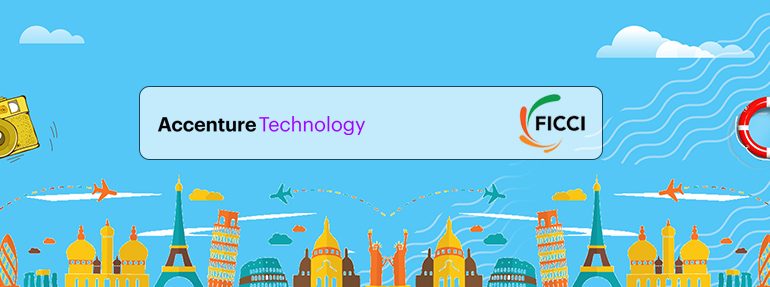
In the second of our series on cross-industry learning, we look at how travel companies could take a leaf out of the innovation book of banking, insurance, and capital markets companies to transform themselves to serve travellers better and stimulate a sustained recovery of the industry. The financial services sector has weathered many a storm (such as the global financial crisis in 2008) and is currently navigating another wrought by the COVID-19 pandemic.
Like in the financial services industry, short-term measures such as stimulus packages, a greater collaboration between government, banks and private sector, and creating cash flows could start the revival process along with adoption of digital technology—from AI to Cloud. In the long run, however, a strong ecosystem play based on value creation will enable growth through innovative ways to serve customers.
Bend the cost curve and build exponential value with what you have
Even as negative revenue growth in 2020 gives the industry compelling reason to cut costs, it must take to heart what the banking sector has learnt in other crises—bend the cost curve rather than myopically slashing costs.
Travel companies striving to repel the wolf at the door must also have a long-term perspective that considers the multiplier impact of cost reductions on value, rather than simply taking action on incremental costs. Identify the cost centres that are needed to help the organization compete and grow. Be strategic about re-investing the money that is saved. For example, taking a cue from banks in redesigning customer journeys – their processes and systems from front to back – equip the workforce with the technology and data to provide a better service.
Build growth opportunities through an ecosystem play
This is the right time for travel to redefine their value chain—much the same way banks are building or joining third-party ecosystems to go beyond traditional relationships and offer more meaningful products and services.
Some banks are not restricting themselves to merely dispensing home loans but also helping mortgage clients with advice on properties, valuation, maintenance checks and discounts, home security, tenant screening, and storage services and even creating buyer-seller communities of engagement. Banks are now collaborating with a variety of fintech companies, giving customers accelerated access to a wide range of innovations—be it on payments, lending, customer experience or risk management.
The travel industry could build similar ecosystems through strategic and tactical partnerships with banks, card companies, digital payments companies, fintech companies, healthcare and public services etc. They must, however, get the right business architecture to align to their business goals and the hyper-personalized needs of their customers.
Data sharing and monetization: Building or joining a third-party could entail the exchange of customer data, either for a fee or other benefits. Robust customer privacy protection must, of course, be in place. And as many customers are willing to share data in exchange for value, it’s time for travel companies to use the data treasure trove they are collecting at every customer touchpoint.
Co-branded travel cards capture valuable data about customer preferences that could be used for tailor-made recommendations for individual customers. Companies could use digital-signal-to-sales solutions to design relevant products and services or solutions—for example, a hospitality solution powered by AI that enables hotel staff to know guest preferences and create inspiring moments that matter across properties.
Such data analytics and AI investments to generate insights and enable data-driven decisions will help companies thrive amidst uncertainty and evolving customer behaviour. Data sharing between airlines, online travel companies, banks, corporates and airports will spawn avenues for building the kind of seamless experiences travellers yearn for.
All these examples highlight the simple fact that shifting the organization’s perspective from costs to value creation puts the customer at the centre even during times of intense pressure to cut costs. But that said, a razor-sharp emphasis on financial restructuring is essential too.
Restructure for financial resiliency
The global financial crisis sent out strong lessons to banks on better management of risks as banks had overleveraged the off-balance-sheet items in their approach to profit maximization. Travel companies too need to manage risks and exercise financial discipline. Riding on pent-up demand for travel isn’t justification enough to buy new aircraft or hotels on the cheap. It might be prudent to carefully assess any heavy capital expenses and maximize leverage of the existing inventory.
Review, reuse, repurpose: Taking stock of inventory and innovatively reusing or repurposing assets would be a better alternative to getting rid of them. Also look at ways to create ancillary revenues to maintain cash flow.
Consider the example of innovative hotel chains that are packaging the concept of work from home as ‘work from hotels’ to corporates. Or take the case of popular restaurants in hotels that have tied up with food delivery apps, thus capitalizing on their verticals.
Similarly, airline companies and airports could design interesting consumer experiences as local attractions along the lines of Singapore Airlines which turned their planes into restaurants. Offer short flight trips over local cities like Qantas’ flights to nowhere. Create VR-based tours of faraway places to generate revenues while also stimulating demand when travel restrictions are removed. Cruise companies could repurpose their ships for shorter cruises or day trips with fewer people to at least cover overheads.
Ensuring financial discipline and creating such alternative revenue sources will position the travel companies to anticipate and outmanoeuvre the next unforeseen disruptions.
Create frictionless and contactless experiences
As the “contactless” theme persists amidst health and safety concerns, it will also influence the development of frictionless experiences as the new way of travel.
Travellers now choose to pay for digital travel with alternative methods such as e-wallets, more often than cards and cash combined, according to the Travel Payments Guide. These alternative methods of payment account for 51% of global travel e-commerce spend.
Single platform integration: As the multiplicity of payment options proliferates there will be a need for a single platform integrating all digital payments. This could help travel create avenues for not only frictionless experience but also engagement and ancillary revenue.
Customer experiences could also be improved with offering the option of paying in easy instalments. Various estimates show 50% of Americans in the 34 to 44-years age group have used ‘buy now, pay later’ credit. It would make sense, therefore, for travel companies to explore innovative partnerships with card companies, banks and fintech companies for solutions to make travel experience smoother.
Go digital but don’t forget the human touch
Against the backdrop of the theme of customer centricity, travel companies investing in AI, data analytics, predictive analytics, digital payments and other advanced technologies, must remember they are doing all this for the customer.
A recent Accenture survey of 47,000 banking customers in 28 markets reveals that the rush to digital in the pandemic and the lack of physical in-branch interactions are depriving banking of its traditional human touch. Customer trust is waning. Only 29% of respondents trust their banks to look after their long-term financial wellbeing, compared with 43% two years ago.
A weakening trust quotient would have negative implications on revenues. An analysis by Accenture of the consequences of this trust deficit revealed that five percent of retail banks’ revenue is at risk. The analysis also shows that this low trust would negate the possibility of a potential nine percent increase in revenue an average retail bank could achieve with innovative digitally enabled advisory services.
Now imagine, what a catastrophe it would be to eliminate the human touch in an industry like travel. Personal interactions and personalization should always be at the heart of all digital.
Go truly green but avoid “greenwashing”
Purpose-driven travel with a deep focus on sustainability will be the hallmark of the new travel era. To understand how to identify the right partners to build sustainable travel practices, consider how financial asset managers are pivoting to green finance guiding investment flows to Environmental, Societal and Governance (ESG) topics. It is all underpinned by the alignment and performance of the company’s sustainability initiatives on the Sustainable Development Goals (SDG) set by the UN.
Conclusion: Just as the financial services sector has become more resilient, competitive, and open to partnerships than ever following the global financial crisis, the travel sector too has the opportunity to reinvent itself through an accelerated digitalization, leveraging data-driven insights, and innovate newer agile business models.
| Authors | Co-Author | |
 Anshul Gupta Associate Director Lead – Travel Industry Advanced Technology Centers in India |
 Rajeev Nair Managing Director Lead – Financial Services Industry Advanced Technology Centers in India |
 Dilip Chenoy Secretary General Federation of Indian Chambers of Commerce & Industry |





